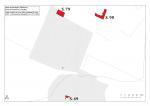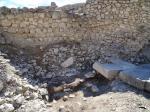Summary (English)
Due to the pandemic, the investigations concentrated on the enclosed part of the site, which corresponds with a part of the public area of the Roman city. Here, recent excavation campaigns have documented building sites relating to the demolition of several large public buildings (the temple-portico complex and theatre).
Forum area
In the forum terrace area, the excavation continued of the western part of the piazza (trench 79). During the last season, archaeological levels were identified, which in addition to confirming the well-attested post antique destruction and reconstruction phases, provided new information on the Roman occupation phases. Indeed, part of the forum’s slab paving was exposed, some of the slabs still in situ and bedded on layers of mortar and gravel. Other, fragmented slabs were found in secondary deposition and constitute further evidence of the reuse of stone materials undertaken when the Roman forum went out of use and was demolished. Continuation of the excavation revealed the phases pre-dating the laying of the limestone slabs. A drainage channel came to light that certainly belonged to a substantial building. The blocks used for the channel were still being worked and this may denote a sudden interruption of the work and a consequent rethinking of the construction.In the eastern sector of the forum (trench 90), the excavations confirmed the diverse use of the area in the Roman period and the subsequent different activities in the post antique period. At least three flanking rooms were identified, the preliminary suggestion being that they were tabernae/storerooms/offices. The foundations were preserved and, in some cases, a modest part of the standing structures. There was no trace of any floor. The structures were demolished and razed with the aim of reusing the area for agricultural purposes. The reconversion of this sector is attested both by the absence of a stratigraphy that could attest a continuity of urban occupation here, and by the presence of wells for water supply and channels, filled with tile/brick fragments, for drainage, which was indispensable given the silty nature of the terrain.
Theatre area
Excavation also continued in the Roman theatre (trench 49), in particular in the orchestra, in one of the post-antique rooms (13th – 16th century), which were built in the southern sector of the building, and outside of them. The excavation of the stratigraphic deposit north of rooms γ and δ is providing more evidence on the phases of the dismantling of the Roman buildings (theatre and temple). The excavated layers were formed by several collapses, dumps and slippage that occurred during the course of time. Inside room δ, the excavation of a part of the theatre’s sewer channel was completed, providing further elements for the reconstruction of the structural changes in this sector.
Director
- Luisa Migliorati - Sapienza Università di Roma
Team
- Alessandra Sperduti - MuCiv, Roma
- Dario Canino- Sapienza Università di Roma e Universitat Autònoma de Barcelona
- Federica Pirré
- Gaia Carosi
- Giulio Casazza
- Ilaria Trivelloni – UNIL - Roma Sapienza
- Tiziana Sgrulloni - Archeoclub d'Italia sede Mentana-Monterotondo
- Ivana Fiore - Roma Sapienza - coll. MuCiv, Roma
- Luisa Migliorati - Sapienza Università di Roma
- Alessandro Vecchione
Research Body
- Roma Sapienza
Funding Body
- Comuni di Prata d’Ansidonia e S. Pio delle camere (AQ)
- Roma Sapienza






![Download [PDF]](/excavation/skins/fasti/images/results/download_sml.png)



